Employing nurse practitioners in general practice: an exploratory survey of the perspectives of managers
Maher Mustafa 1 5 , Sue Adams 2 , Corinne Bareham 3 4 , Jenny Carryer 11 School of Nursing, Massey University, Palmerston North, New Zealand.
2 School of Nursing, University of Auckland, Auckland, New Zealand.
3 School of Psychology, Massey University, Palmerston North, New Zealand.
4 Victoria University of Wellington, Wellington, New Zealand.
5 Corresponding author. Email: kiwiphd@hotmail.com
Journal of Primary Health Care 13(3) 274-282 https://doi.org/10.1071/HC21036
Published: 28 September 2021
Journal Compilation © Royal New Zealand College of General Practitioners 2021 This is an open access article licensed under a Creative Commons Attribution-NonCommercial-NoDerivatives 4.0 International License
Abstract
INTRODUCTION: Establishing the nurse practitioner (NP) workforce in New Zealand is a viable solution to health and workforce challenges in primary health care. General practices have been slow to implement NP services. Managers of general practices are central to the employment and development of NP roles.
AIM: To explore the perspectives of managers on employing NPs in general practice.
METHODS: An electronic survey was used to collect demographic and numerical data, which were analysed descriptively and analytically using SPSS (version 26). Written answers to open-ended questions were analysed qualitatively.
RESULTS: In total, 143 managers participated in the survey (response rate 39.7%); 54 (37.8%) worked in practices employing at least one NP. Of respondents, 88.9% (n = 127) agreed or strongly agreed that NPs could enhance continuity of care (89/143, 62.2%), improved access to services and medications (89/143, 62.2%) and filled a gap that added value to health care (97/143, 67.8%). Practices employing NPs had statistically significant higher levels of agreement about the advantages of NPs than practices not employing NPs. Challenges and enablers to employing NPs were themed under organisational environment, NP scope of practice and role, and NP workforce development.
DISCUSSION: This exploratory study revealed that there is little knowledge about the NP workforce in surveyed general practices. Ongoing work is required to improve knowledge for employing general practices, including dissemination of information about NP education and training, scope and models of care, and ability to generate business income.
KEYwords: Primary health care; workforce; health research; health services; models of care; nursing roles; health management.
| WHAT GAP THIS FILLS |
| What is already known: Nurse practitioners (NPs) are a health workforce solution for delivering primary care services, including in underserved, rural, and high-needs communities. They access the same funding mechanisms as general practitioners through enrolment with primary health organisations. |
| What this study adds: Although most general practice managers participating in this research acknowledge the potential of the NP workforce, it is those who already work with and manage NPs who recognise their positive impact in practice. Managers need more information about the scope of practice and role of NPs and support to establish NP positions in general practice. |
Introduction
The health sector in New Zealand is facing a shortage of general practitioners (GPs), with 31% intending to retire within the next 5 years.1 The nurse practitioner (NP) workforce offers a viable cost-effective solution to increasing access to primary care services, alleviating pressure on both GPs and secondary care.2 Although there is little robust research internationally, systematic reviews suggest that nurses can deliver primary care services that are safe, with some comparable outcomes to doctors and improved patient satisfaction.3,4 NPs work within a paradigm that bridges biomedicine and nursing, delivering a broad range of services with a focus on reducing health inequalities.5–7
The number of NPs in New Zealand is growing steadily, reaching 530 registered NPs by March 2021.8 Approximately 60% of NPs work in areas broadly defined as primary health care, including general practices, aged care, community nursing, mental health services, and public health.9 A survey conducted in 2019 showed that of 151 NPs working in these primary care settings, 58% worked at least some of their time in general practices.10 Of these, 43% worked in Very Low Cost Access practices, compared to 24% of GPs in 2017;11 and 34% in integrated family health centres.10 Nearly one-half of all primary care NPs worked in more than one clinical setting.10
The introduction of the NP role has required general practices to rethink models of care delivery, new functions and relationships between health practitioners and organisational policies and processes.10,12,13 Internationally, barriers to integrating NPs into general practices have included isolation in mainly medically led environments, lack of team preparation, confusion in role definitions, availability of resources and equipment, and inadequate colleague interaction and support.12,14,15 Adams and Carryer reported that in New Zealand, commitment from employing organisation, collegial and peer support, and knowledge of the role and scope of NPs, were central to successfully establishing a NP role.16
Although New Zealand has a robust legislative, educational, and registration framework, comparable to the United States, Canada, and Australia, the growth of the NP workforce in general practices has been relatively slow.16 In New Zealand, NPs are advanced nurses with at least 4 years of experience in their area of clinical practice and a clinical Master’s degree in Nursing (or equivalent).17 They are authorised prescribers and able to work autonomously to assess, order diagnostic tests, diagnose, treat or prescribe, manage, and refer.17 They access capitation and General Medical Service payments in the same way as GPs, provide insurance and medical certificates, certify death, and issue standing orders.18 NPs are not legally required to have supervision or practice within constraining protocols, as is the case in some countries.
Most primary care in New Zealand is delivered by GP-owned general practices run as private businesses, with increasing numbers of for-profit corporate models.1,19 In the minority are third-sector organisations (non-government, non-profit), including Māori health providers, Pacific health providers, and community- or iwi-owned Trusts. A very low, but growing, number of NPs own or joint-own general practices. NPs are mainly employees or contracted to deliver primary care services.10 This study aimed to explore general practice managers’ perspectives of employing NPs using an exploratory descriptive survey. The study provides direction for the ongoing establishment of NPs in primary care.
Methods
An 18-question electronic survey was developed, piloted with NP experts, and administered using SurveyMonkey® to collect demographic data, numerical data, and written answers to open-ended questions from managers working in primary care. The survey drew on international and local workforce research on NPs,13,14,16 and collected information on practice location and type of practice; respondent information (including role, experience, and education); perceived advantages of NPs; barriers to employing NPs; and overcoming challenges to employing NPs. Data were collected using multi-choice and multi-select items using five-point Likert scales ranging from ‘strongly agree’ to ‘strongly disagree’. Open-ended questions prompted free-text entry. The study was approved by Massey University Human Ethics Committee as low-risk (No.: 4000020878).
Respondents were recruited from mail-outs distributed by the College of Nurses Aotearoa (NZ) Inc. and the Practice Managers and Administrators Association of New Zealand (PMAANZ). Approximately 800 emails were sent, reaching an estimated 360 general practices. The invitation requested responses from a management perspective on the employment of NPs and addressed practice managers, business owners, or team leaders. Participants self-selected. A follow-up email was sent 2 weeks later. The anonymised survey took on average 10–15 min to complete. Data were collected between 1 June and 18 July 2019.
Quantitative data were analysed by MM and CB using the Statistical Package for Social Sciences (SPSS) software version 26 (SPSS Inc.). After coding and cleaning the data, proportions and frequencies were calculated. Categories that ‘agree’ and ‘strongly agree’ on five-point Likert scales were combined for analysis. Z-tests were conducted to test differences between respondents from practices that employ at least one NP and respondents from practices that do not employ NPs. The null hypothesis for a Z-test was that there is no difference between the two groups and P < 0.05 was interpreted as indicating a statistically significant difference.
Content analysis20 was applied to qualitative data collected from open-ended questions in the survey. Two researchers (MM and SA) independently inductively coded the free-text responses, identifying patterns, similarities, and differences. Each researcher created a coding structure with emergent themes and sub-themes, which was then compared, consensus reached, and then re-coded and counted. Quotes have been used to substantiate the findings.
Results
Participants were 143 eligible contacts who completed the survey; response rate was 39.7% (143/360). Responses were received from practices in every District Health Board region and 85.3% of respondents (122/143) were female. The sample had diverse backgrounds. Just over half (n = 81, 56.6%) had a business or health management background, 28 (19.6%) nursing, 8 (5.6%) medicine; and 21 (14.7%) had no formal preparation. Eighty-six (60.1%) had worked in their current position for >5 years.
Most respondents 90.3% (n = 129) were from clinical settings described as general practice, corporate-owned general practice, or integrated family health centres. Eight respondents (5.6%) were from an iwi or Māori health provider (all employing at least one NP). Of the total responses, 89 (62.2%) worked in a practice that did not employ any NPs and 54 (37.8%) worked in a practice employing ≥1 NP (Figure 1).
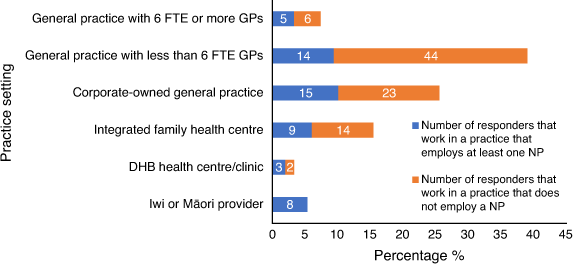
|
More than half (n = 78, 54.5%) of the respondents worked in practices located within 30 min of a major hospital and 24 (16.8%) were located >60 min from a major hospital. Of the 54 practices employing ≥1 NP, 30 (55.5%) were located within 30 min of a major hospital and nine (16.7%) in practices located >60 min from a major hospital.
Perceived advantages of the NP role
Managers were asked to record their level of agreement on advantages of the NP role. Only 127 (88.8%) respondents answered this set of questions; 77 in practices that did not employ a NP (Figure 2), and 50 from practices employing ≥1 NP (Figure 3). When compared statistically, in all except one item, respondents who managed ≥1 NP were more likely to agree or strongly agree with perspectives relating to the positive impact of NPs (Table 1). The only non-significant result was where both groups of respondents agreed that NP practice offered increased choice for patients (Table 1).
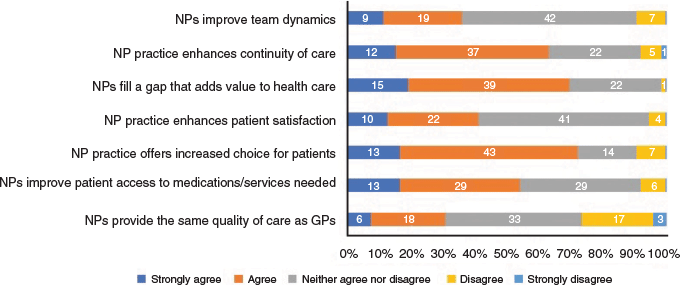
|
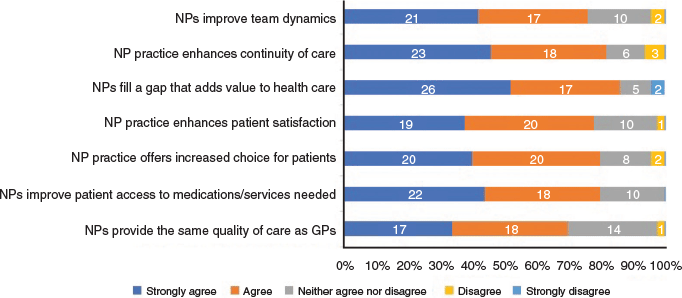
|

|
Barriers to employing a NP
All respondents multi-selected items as barriers to employing a NP from a list derived from the literature.13,14 Table 2 shows the number of responses counted for each barrier, together with responses by participants employing and not employing a NP. Generally, there were no significant differences between groups in reported barriers. The most frequently cited barrier for both groups was persisting confusion about the roles of GPs and NPs (n = 40, 28%). Respondents not employing NPs were more likely to cite the limitation of space (P = 0.01) and the reluctance of GPs to delegate (P = 0.03) as barriers.
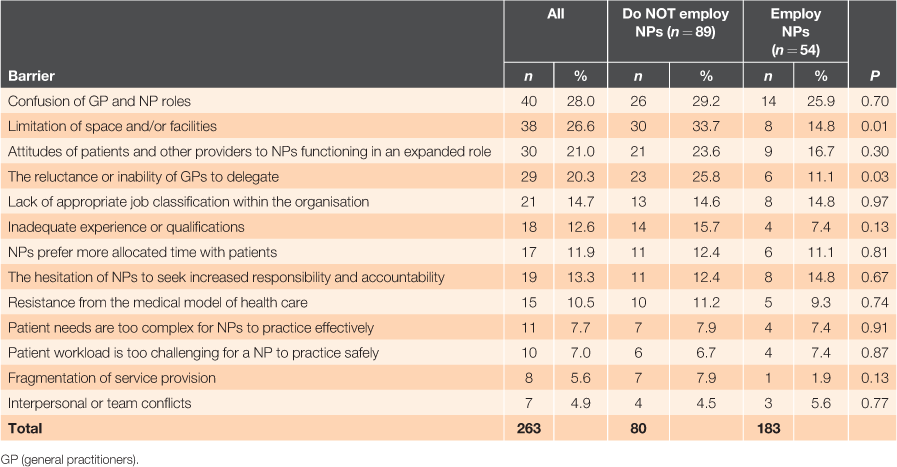
|
Overcoming challenges to employing NPs in general practices
Respondents were asked to state in a free-text field the three most important factors to overcome the challenges to employing or retaining NPs; 109 respondents made a total of 276 statements that were coded and themed (Table 3). Three main themes emerged; organisational environment (113 statements, 41%); NP scope of practice and role (66 statements, 24%); and NP workforce development (97 statements, 35%), with various sub-themes under each main theme.
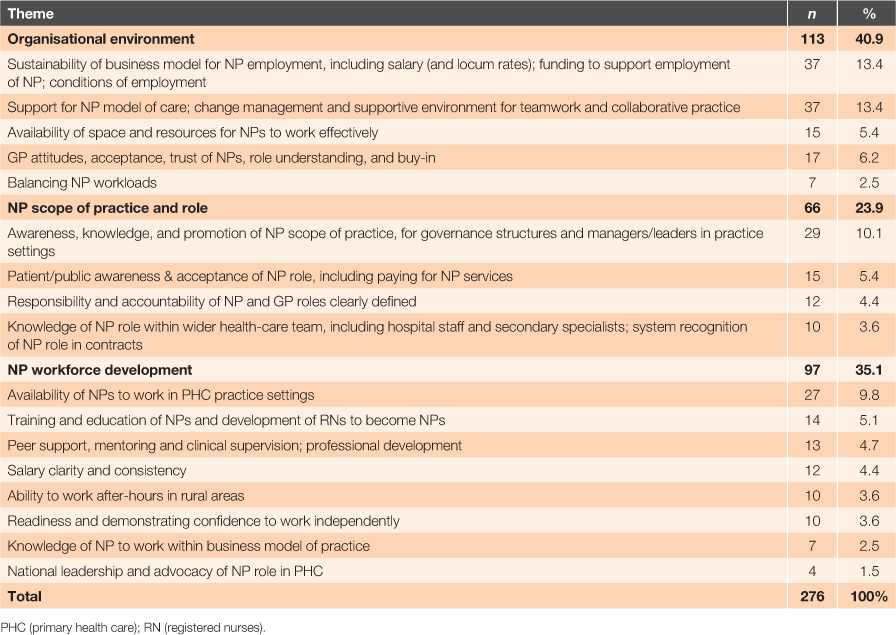
|
Organisational environment
It was evident that cost, funding, and NP salary were issues requiring attention. Concerns included:
‘They are expensive and [I’m] not sure how independently they can work.’
‘They want the same amount of money as [the] manager, and not much less than a doctor.’
‘The Boards, employers, are shocked at the cost of employing the nurse as an NP, and seem unprepared for that next step of [the] employment process.’
There were mixed responses in relation to GPs’ readiness to work with NPs, and the need to overcome any existing resistance and reduce the ‘so called threat’ was mentioned. Some respondents commented that they were unsure how NPs generated income and how they would fit into the current practice and business model:
‘GP is … concern[ed] over [the] ability [of NP] to generate sufficient income to meet cost.’
‘[A NP] does not suit our business model.’
‘[We] don’t see any need for any [NPs] and don’t need to change what we’re doing because it’s working fine.’
‘We have been unable to integrate the NP into our model of care.’
Others saw that the NP role offered the opportunity to change the medical model, by:
‘Altering the current model of care that is currently very GP centric.’
One manager described:
‘[NPs] are more of an asset to a practice than most regular GPs.’
Gaining ‘buy-in’ across the practice was important, along with information and training to implement NP roles. One respondent stated:
‘I am a business manager and would love to hire a NP. There needs to be more visibility and education to medical businesses around the skills of a NP.’
Nurse practitioner scope of practice and role
The need for knowledge of the NP scope of practice and role were described. One employer stated:
‘While there are expanding care teams, little or no support has been put in place to ensure we capitalise on the potential of each expanded team member…. What is often missing is the actual operational aspects of how.’
Frequent comments were made in relation to GPs and nurses needing to better understand the role of the NP; for example:
‘GPs find it hard to define what NPs can and can’t do.’
‘[There is a need] for education for GPs and practice nurses regarding the role of a NP and the value they can bring to general practice.’
Similarly, an educational need was identified for other health-care workers, including hospital specialists and patients:
‘[We] need to promote the benefits of having a NP to staff, management, [and] patients.’
Although some respondents perceived resistance from patients to seeing a NP, others stated that NPs ‘improve access’ and ‘enhance patient satisfaction’.
Nurse practitioner workforce development
The availability of NPs to work in general practice was most frequently described as requiring change. Nine respondents implied that they had attempted to recruit a NP in the past without success. Although practices of 11 participants were in the process of training one or more NPs, others identified the need for more information on the educational pathway, costs, and supervision required for NP training. However, one respondent stated:
‘We put a NP through training, but did not have a position for her when she graduated because we were overstaffed by doctors at the time.’
Once registered, the importance of peer support and ongoing mentoring was stated. One practice manager described:
‘In our practice there has been no barrier to employing our NP. She is fantastic and highly experienced. A recent experience with a locum NP has shown that the workload is challenging for new NPs. If we were employing a new NP with less experience, we would provide teaching, as we would with a registrar, and an ongoing support programme.’
There was a range of areas where improved clarity was required, including national information on salaries and the need for NPs to know about the practice’s business model.
Discussion
This exploratory survey has described barriers and enablers to employing NPs in primary care general practice from the perspective of 143 managers, adding to a growing body of knowledge about establishing primary care NP roles in New Zealand.5,10,16,21–23 Although most managers in this study affirmed international research that NPs offer positive outcomes for patients,2–4 there were significant differences between the perspectives of participants with experience of working with and managing NPs and those without this experience. This affirms anecdotal reports in New Zealand that once a practice team has worked with a NP, their acknowledgment and understanding of the value of the NP role is realised. There is a need for more available and transparent information on the nature and role of NPs, including how to develop and implement models of care within the existing structures of primary care organisation and funding. Establishing collaborative practice teams, organisational processes to support service delivery models, and business models with cost-benefit analyses are important enablers to implementing NP roles.13–16
The survey revealed mixed levels of knowledge about NPs, which act as barriers to effective utilisation. Key areas of incorrect or inadequate knowledge related to NPs’ scope of practice and their potential contribution including the degree of autonomy and independence in NP practice, whether ongoing supervision is required, appropriate remuneration and the income-generating potential of NPs for the employing business. Confusion is further exacerbated when NPs are new to the role and, as for any novice, finding their way and seeking support. Perceived confusion around the scope of NP practice requires reframing professional roles and activities within practices.24,25 Yet, where NPs and GPs do work together, there is a willingness to overcome system-level barriers and develop collegial relationships and collaborative practice models.26,27 Mutual respect and trust, effective communication, and a shared philosophy of care are crucial to the development of these interprofessional relationships,25,27 with these attributes supported in policy and funding arrangements.26,28
A degree of frustration was evident that potential employers in this study found it difficult to locate NPs for vacancies, including in rural areas. Registered nurses remain the only workforce evenly distributed across rural areas and small towns in New Zealand.23 Managers wanted more information about how registered nurses become NPs and the requirements for clinical practice, supervision, and education. Although Ministry of Health initiatives promote the NP workforce in rural and primary care settings,29,30 a process of local investment and support is required to develop the NP workforce.10 The NP workforce offers potential for highly cost-effective and accessible primary care for a sector under considerable workforce stress.5
Legislative, policy, and funding impediments to allow NPs to be fully viable members of general practice teams have steadily been removed since the NP role inception in 2001. NPs are a vital factor in maintaining sustainability of service delivery, but this survey reveals often poorly embedded knowledge at a practice level about the NP workforce. Exemplars, case studies, and further research is needed to share information from practices that have successfully established the role.
Limitations to this study include the small sample size recruited using a non-probability approach through distribution of a survey via two organisations. The denominator and response rate is estimated on this membership. Respondents self-selected to offer a management perspective from primary care practices. Caution needs to be applied when interpreting the results. Qualitative data were limited to open-text responses.
Competing interests
The authors declare no competing interests.
Funding
This research did not receive any specific funding.
Acknowledgements
We would like to thank all participants for their time and extensive comments.
References
[1] Royal New Zealand College of General Practitioners. 2020 general practice workforce survey: summary report – final. Wellington: RNZCGP; 2020. [cited 2021 June 8]. Available from: https://www.rnzcgp.org.nz/RNZCGP/Publications/The_GP_workforce/RNZCGP/Publications/GP_workforce.aspx?hkey=a7341975-3f92-4d84-98ec-8c72f7c8e151[2] Liu CF, Hebert PL, Douglas JH, et al. Outcomes of primary care delivery by nurse practitioners: utilization, cost, and quality of care. Health Serv Res. 2020; 55 178–89.
| Outcomes of primary care delivery by nurse practitioners: utilization, cost, and quality of care.Crossref | GoogleScholarGoogle Scholar | 31943190PubMed |
[3] Martínez-González NA, Djalali S, Tandjung R, et al. Substitution of physicians by nurses in primary care: a systematic review and meta-analysis. BMC Health Serv Res. 2014; 14 214
| Substitution of physicians by nurses in primary care: a systematic review and meta-analysis.Crossref | GoogleScholarGoogle Scholar | 24884763PubMed |
[4] Laurant M, van der Biezen M, Wijers N, et al. Nurses as substitutes for doctors in primary care. Cochrane Database Syst Rev. 2018; 7 CD001271
| Nurses as substitutes for doctors in primary care.Crossref | GoogleScholarGoogle Scholar | 30011347PubMed |
[5] Carryer J, Adams S. Nurse practitioners as a solution to transformative and sustainable health services in primary health care: a qualitative exploratory study. Collegian. 2017; 24 525–31.
| Nurse practitioners as a solution to transformative and sustainable health services in primary health care: a qualitative exploratory study.Crossref | GoogleScholarGoogle Scholar |
[6] Browne AJ, Tarlier DS. Examining the potential of nurse practitioners from a critical social justice perspective. Nurs Inq. 2008; 15 83–93.
| Examining the potential of nurse practitioners from a critical social justice perspective.Crossref | GoogleScholarGoogle Scholar | 18476851PubMed |
[7] Poghosyan L, Carthon JMB. The untapped potential of the nurse practitioner workforce in reducing health disparities. Policy Polit Nurs Pract. 2017; 18 84–94.
| The untapped potential of the nurse practitioner workforce in reducing health disparities.Crossref | GoogleScholarGoogle Scholar | 28766986PubMed |
[8] Nursing Council of New Zealand. Mātanga Tapuhi Nurse Practitioner Workforce. Wellington: Nursing Council of New Zealand; 2021. [cited 2021 May 18]. Available from: https://www.nursingcouncil.org.nz/Public/News_Media/NCNZ/News-section/news-item/2021/2/M%C4%81tanga_Tapuhi_%20Nurse_Practitioner_Workforce.aspx
[9] Nursing Council of New Zealand. The New Zealand nursing workforce: a profile of nurse practitioners, registered nurses and enrolled nurses 2018–2019. Wellington: Nursing Council of New Zealand; 2019. [cited 2019 October 11]. Available from: https://www.nursingcouncil.org.nz/Public/News_Media/Publications/Workforce_Statistics/NCNZ/publications-section/Workforce_statistics.aspx?hkey=3f3f39c4-c909-4d1d-b87f-e6270b531145
[10] Adams S, Boyd M, Carryer J, et al. A survey of the NP workforce in primary healthcare settings in New Zealand. N Z Med J. 2020; 133 29–40.
| 33032301PubMed |
[11] Royal New Zealand College of General Practitioners. 2017 general practice workforce survey: part 2. Wellington: RNZCGP; 2018. [cited 2021 March 18]. Available from: https://www.rnzcgp.org.nz/gpdocs/new-website/publications/GP-workforce/FinalWorkforceSurvey2017Report2.pdf
[12] Chouinard V, Contandriopoulos D, Perroux M, Larouche C. Supporting nurse practitioners’ practice in primary healthcare settings: a three-level qualitative model. BMC Health Serv Res. 2017; 17 437
| Supporting nurse practitioners’ practice in primary healthcare settings: a three-level qualitative model.Crossref | GoogleScholarGoogle Scholar | 28651529PubMed |
[13] Scanlon A, Murphy M, Tori K, Poghosyan L. A national study of Australian nurse practitioners’ organizational practice environment. J Nurse Pract. 2018; 14 414–8.e3.
| A national study of Australian nurse practitioners’ organizational practice environment.Crossref | GoogleScholarGoogle Scholar |
[14] Poghosyan L, Nannini A, Smaldone A, et al. Revisiting scope of practice facilitators and barriers for primary care nurse practitioners: a qualitative investigation. Policy Polit Nurs Pract. 2013; 14 6–15.
| Revisiting scope of practice facilitators and barriers for primary care nurse practitioners: a qualitative investigation.Crossref | GoogleScholarGoogle Scholar | 23528433PubMed |
[15] Torrens C, Campbell P, Hoskins G, et al. Barriers and facilitators to the implementation of the advanced nurse practitioner role in primary care settings: a scoping review. Int J Nurs Stud. 2020; 104 103443
| Barriers and facilitators to the implementation of the advanced nurse practitioner role in primary care settings: a scoping review.Crossref | GoogleScholarGoogle Scholar | 32120089PubMed |
[16] Adams S, Carryer J. Establishing the nurse practitioner workforce in rural New Zealand: barriers and facilitators. J Prim Health Care. 2019; 11 152–8.
| Establishing the nurse practitioner workforce in rural New Zealand: barriers and facilitators.Crossref | GoogleScholarGoogle Scholar | 32171358PubMed |
[17] Nursing Council of New Zealand. Competencies for the nurse practitioner scope of practice. Wellington: Nursing Council of New Zealand; 2017. [cited 2020 November 25]. Available from: https://www.nursingcouncil.org.nz/NCNZ/Education-section/Nurse_practitioner.aspx
[18] Ministry of Health. Nurse practitioners in New Zealand. Wellington: Ministry of Health; 2017. [cited 2020 December 7]. Available from: https://www.health.govt.nz/our-work/nursing/nurses-new-zealand/nurse-practitioners-new-zealand#:~:text=1.,same%20authority%20as%20medical%20practitioners
[19] Goodyear-Smith F, Ashton T. New Zealand health system: universalism struggles with persisting inequities. Lancet. 2019; 394 432–42.
| New Zealand health system: universalism struggles with persisting inequities.Crossref | GoogleScholarGoogle Scholar | 31379334PubMed |
[20] Bengtsson M. How to plan and perform a qualitative study using content analysis. NursingPlus Open. 2016; 2 8–14.
| How to plan and perform a qualitative study using content analysis.Crossref | GoogleScholarGoogle Scholar |
[21] Kirkman A, Wilkinson J, Scahill S. Thinking about health care differently: nurse practitioners in primary health care as social entrepreneurs. J Prim Health Care. 2018; 10 331–7.
| Thinking about health care differently: nurse practitioners in primary health care as social entrepreneurs.Crossref | GoogleScholarGoogle Scholar | 31039962PubMed |
[22] Adams S, Carryer J. How the institutional and policy context shapes the establishment of nurse practitioner roles and practice in New Zealand’s primary health care sector. Policy Polit Nurs Pract. 2021; 22 17–27.
| How the institutional and policy context shapes the establishment of nurse practitioner roles and practice in New Zealand’s primary health care sector.Crossref | GoogleScholarGoogle Scholar | 33054593PubMed |
[23] Carryer J, Boddy J, Budge C. Rural nurse to nurse practitioner: an ad hoc process. J Prim Health Care. 2011; 3 23–8.
| Rural nurse to nurse practitioner: an ad hoc process.Crossref | GoogleScholarGoogle Scholar | 21359257PubMed |
[24] Brault I, Kilpatrick K, D’Amour D, et al. Role clarification processes for better integration of nurse practitioners into primary healthcare teams: a multiple-case study. Nurs Res Pract. 2014; 2014 170514
| Role clarification processes for better integration of nurse practitioners into primary healthcare teams: a multiple-case study.Crossref | GoogleScholarGoogle Scholar | 25692039PubMed |
[25] Norful AA, de Jacq K, Carlino R, Poghosyan L. Nurse practitioner-physician comanagement: a theoretical model to alleviate primary care strain. Ann Fam Med. 2018; 16 250–6.
| Nurse practitioner-physician comanagement: a theoretical model to alleviate primary care strain.Crossref | GoogleScholarGoogle Scholar | 29760030PubMed |
[26] Schadewaldt V, McInnes E, Hiller JE, Gardner A. Experiences of nurse practitioners and medical practitioners working in collaborative practice models in primary healthcare in Australia: a multiple case study using mixed methods. BMC Fam Pract. 2016; 17 99
| Experiences of nurse practitioners and medical practitioners working in collaborative practice models in primary healthcare in Australia: a multiple case study using mixed methods.Crossref | GoogleScholarGoogle Scholar | 27473745PubMed |
[27] MacLellan L, Higgins I, Levett-Jones T. Medical acceptance of the nurse practitioner role in Australia: a decade on. J Am Assoc Nurse Pract. 2015; 27 152–9.
| Medical acceptance of the nurse practitioner role in Australia: a decade on.Crossref | GoogleScholarGoogle Scholar | 24895143PubMed |
[28] Tenbensel T, Miller F, Breton M, et al. How do policy and institutional settings shape opportunities for community-based primary health care? A comparison of Ontario, Quebec and New Zealand. Int J Integr Care. 2017; 17 13
| How do policy and institutional settings shape opportunities for community-based primary health care? A comparison of Ontario, Quebec and New Zealand.Crossref | GoogleScholarGoogle Scholar | 28970754PubMed |
[29] Cassie F. $9.2 million boost supports training and primary care placements for mental health nurses. NZ Doctor. 2020 (12 Aug). [cited 2021 March 3]. Available from: https://www.nzdoctor.co.nz/article/print-archive/92-million-boost-supports-training-and-primary-care-placements-mental-health
[30] Cassie F. Ministry funds will support extra nurse practitioners in rural services. NZ Doctor. 2020 (27 May). [cited 2021 March 3]. Available from: https://www.nzdoctor.co.nz/article/news/ministry-funds-will-support-extra-nurse-practitioners-rural-services


